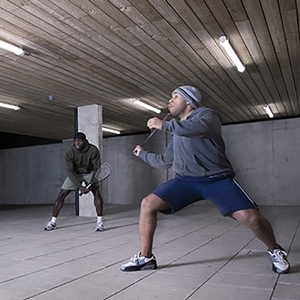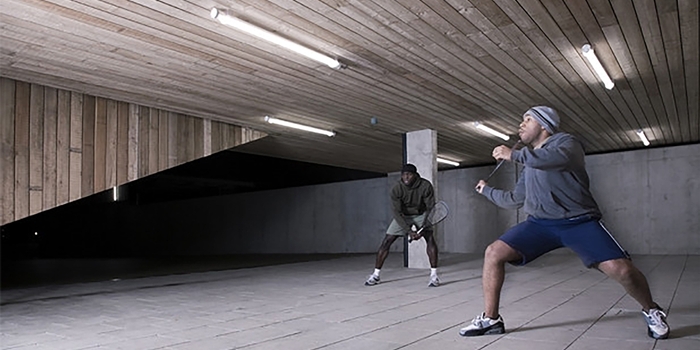Play Squash, Get Fit
![]()
May 7, 2018
David Oxberry / Getty Images
by Michael Steinberger
Squash — the racket sport — is a game of genteel savagery. Popular with Ivy leaguers, Wall Streeters, and country club types (though hardly limited to them), squash also happens to be a brutal test of stamina and willpower, and perhaps the best 45-minute workout you'll ever experience (a half-hour of vigorous squash can burn up to 500 calories). In other words, it is a hell of a lot of fun.
Squash is played in a small square court, measuring just 32 feet from front to back and 21 feet across, and consists of hitting a ball against the 15-foot high front wall. When you see squash for the first time, you might think, "How hard can that be?" When you play it for the first time, and your lungs and thighs are burning after five minutes, you'll have your answer.
The reason squash is so physically demanding is because it is played with a squishy ball that is hard to put away. It is possible to hit outright winners, kill shots that catch the front corner just above the tin (the 19-inch high metal strip that runs along the bottom of the front wall and above which the ball must be hit) and roll dead. But those are hard to come by, and because the court is so compact, there are very few shots that a player with decent speed and flexibility can't run down. Also, in contrast to tennis, you almost never get free points off the serve in squash — aces are exceedingly rare (and pretty much nonexistent at the highest levels). In squash, the serve is used just to start the point; a particularly well-struck serve might put the opponent on the defensive, but that's the most help you're likely to get from the serve.
Racket skills do matter, to a certain extent. Balls played along the side walls, known as rail shots, are the building block of just about every point. The goal with rail shots is to keep your opponent pinned in the back of the court or, better yet, to force a loose ball that you can then attack. This takes precision — keeping your rail shots tight to the wall and controlling the middle of the court, an area known as the T. Good volleying is also essential; the more balls you can cut off in the air, the easier it is to control the T.
But if you put two players of roughly equal ability on the court, chances are the match is going to come down to conditioning. Squash is a war of attrition, in which victory is attained by keeping your opponent on the move until he no longer wants to move, and the fitness factor is often the deciding factor. Some of the sport's biggest stars were as renowned for their training regimens as they were for their on-court exploits. Geoff Hunt, an Aussie who was the number one ranked player in the world in the late '70s, was known for his interval training: He would do 26 400-meter sprints — 26! — completing each lap of the track in 75 seconds and resting for 60 seconds between each one. You don't need to go that far, but it definitely helps to have a strong fitness base when you play squash. (If you are out of shape and over the age of 40, it is best to do some cardio and strengthening work before you even try to play.)
A Cheat Sheet for the Squash Newcomer:
Equipment: You are going to need a racket. Top-of-the-line sticks cost as much as top-of-the-line tennis rackets, but you can get a perfectly good squash racket for $50–$75. Head, Wilson, and Dunlop are the brands you want to look for in that price range. You are also going to need the right footwear. Most clubs require players to wear sneakers with non-marking rubber soles (running sneakers, and even tennis sneakers, can scuff up squash courts). Also — and this is really important — you need protective goggles. They are required by the United States Squash Racquets Association, and for good reason — the court is small, players do a lot of jostling, and errant swings happen. A pair of goggles will set you back $20–$25.
Lessons: If you are new to the game, it's helpful to get some lessons. You'll learn the basics, and you'll have a lot more fun once you start playing. Lessons are typically around $75 and up for 45 minutes or an hour. If you have a friend who's also interested in taking up squash, you can think about doing joint lessons.
The Rules: In squash, the ball is played off the front wall, above the tin, and below the out-of-bounds line. It can hit the front wall directly, or it can be played off the side walls or even the back wall (shots played off the side or back walls must be within the out-of-bounds lines on those walls, as well). However it gets there, the ball must hit the front wall on the fly. Players can take the ball out of the air or they can play it after the first bounce; if it bounces more than once, the ball is ruled dead. Each point begins with a serve. You only get one chance; in contrast to tennis, there's no second serve in squash. The server must keep one foot in the service box while serving, the ball must hit the front wall directly and on the fly, it has to hit the front wall above the service line and below the out of bounds line, and it must land on the opposite side of the court behind what's called the short line (a line that runs between the side walls and which is approximately 14 feet from the front wall, seven feet from the back wall). Matches are best-of-five games, and games are played to 11. However, you have to win by two points — if the players are tied 10–10, the game continues until someone wins two consecutive points. Points can be won on your serve or on your opponent's serve.
Before You Play: You should stretch like crazy before you start playing. Pay particular attention to your calves (Achilles injuries are common in the game). Also, make sure you do some warm-up jogging before you play. All that said, you can expect to be very sore after your first time playing — especially in your hindquarters. Squash is a fantastic game, but it can literally be a pain in the ass.
See squash in action at our weekly Pro Match every Wednesday night at 6:30pm.

